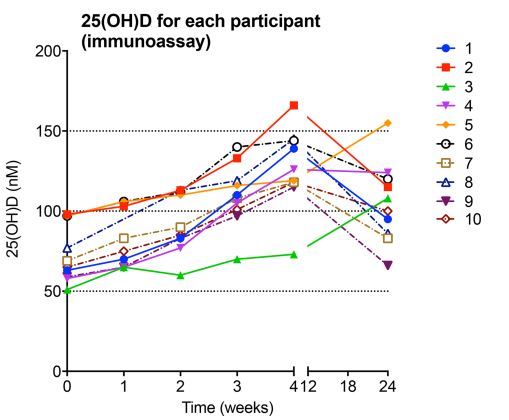Vitamin D injection of 600,000 IU (response by 10 individuals)
High-Dose Intramuscular Vitamin D Provides Long-Lasting Moderate Increases in Serum 25-Hydroxvitamin D Levels and Shorter-Term Changes in Plasma Calcium.
J AOAC Int. 2017 Sep 1;100(5):1337-1344. doi: 10.5740/jaoacint.17-0087. Epub 2017 May 11.
Gorman S1, Zafirau MZ2, Lim EM3, Clarke MW4, Dhamrait G1, Fleury N1, Walsh JP5, Kaufmann M6, Jones G6, Lucas RM 7.
📄 Download the PDF from VitaminDWiki
10 people - variety of ages, all with 1 or more health problems



The best management of vitamin D deficiency, defined as a 25-hydroxyvitamin D [(25(OH)D] level <50 nM, is unclear. Intramuscular (IM) injection of a large bolus of vitamin D (≥100 000 IU) is used, but its safety is uncertain. In 10 adults given an IM injection of 600 000IU vitamin D3, we measured at baseline and at 1, 2, 3, and 4 weeks postinjection the serum levels of vitamin D3, 25(OH)D3, 25(OH)D2, total 25(OH)D, 3-epi-25(OH)D3, and 24,25-dihydroxyvitamin D3 [24,25(OH)2D3] using a standardized LC with tandem MS (MS/MS) assay; serum levels of 25(OH)D using the Abbott ARCHITECT i2000 immunoassay; and markers of bone metabolism. Bone markers and 25(OH)D (immunoassay) were remeasured at 24 weeks. All participants had baseline total 25(OH)D levels >50 nM. Serum 25(OH)D levels increased at 3, 4, and 24 weeks postinjection, peaking at 4 weeks [mean ± SEM of 126 ± 7.9 nM (immunoassay) and 100 ± 5.5 nM (LC-MS/MS)] but generally remained <125 nM, the upper limit recommended by the U.S. Institute of Medicine. Serum 24,25(OH)2D3 levels increased at 3 and 4 weeks postinjection. Serum ionized calcium levels were higher than baseline at 1, 3, and 4 weeks postinjection but remained within the clinically normal range. Other biochemical parameters, including other vitamin D metabolites, plasma alkaline phosphatase, and parathyroid hormone levels, were unchanged. IM injection of a large bolus of vitamin D effectively increases serum 25(OH)D levels without evidence of metabolic abnormality.
PMID: 28492140 DOI: 10.5740/jaoacint.17-0087
